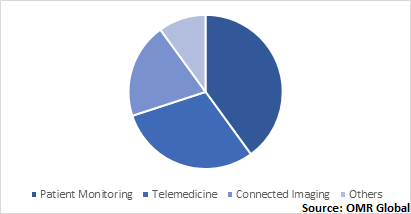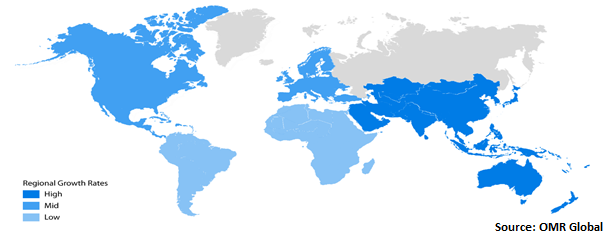IoT Healthcare Market
Global IoT Healthcare Market Size, Share & Trends Analysis Report by Component (Hardware and Software & Services), Application (Patient Monitoring, Telemedicine, Connected Imaging, and others), End-ser (Healthcare Providers, Healthcare Payers, Research Laboratories) Forecast Period 2021-2027 Update Available - Forecast 2025-2035
The global IoT healthcare market is anticipated to grow at a CAGR of around 16.8% during the forecast period. IoT enables the healthcare professional to connect with the patients more proactively. The data collected through IoT devices support the physicians to devices on the best treatment option for the patient. Certain benefits of IoT healthcare include cost reduction, productivity and more efficiency, enhanced customer experience and mobility and agility.
The increased adoption of health and fitness due to COVID-19 will be increasing the use of real-time health monitoring increasing the IoT healthcare market. Rise of usage of connected technology devices to manage operational as well as clinical tasks further drives the growth of the market. Large adoption of electronic health records (EHR) has been the major factor driving the market growth. Additionally, rising investments from major healthcare IT companies and increasing healthcare spending acts as some major motivators for the market. Moreover, the rising geriatric population creates demand for remote monitoring and EHR applications.
High costs of IoT healthcare along with lack of skilled professionals towards this technology act as major restraints for the market growth. The reason behind the high cost is the requirement of the installation of software, hardware, training fees, networking infrastructure, &IT support. However, ongoing improvements in healthcare expenditure and rising demand for IoT healthcare in developing countries are expected to drive the market growth in developing countries in the upcoming years.
Segmental Outlook
The global IoT healthcare market is classified on the basis of components, application and end-user. based on the component market is segmented into hardware and software & services. Based on applications, the market is classified into patient monitoring, telemedicine, connected imaging, and others. On the basis of end-user, the market is segmented into hospitals & clinics, clinical research organization, research laboratories, and others.
Global IoT Healthcare Market Share by Application, 2020 (%)

Patient Monitoring Technology is Anticipated to Dominate the Global IoT Healthcare Market
Among application, the patient monitoring segment is projected to dominate the market growth due to the rise in adoption of home and remote patient monitoring devices coupled with the increasing prevalence of lifestyle diseases such as diabetes, obesity, cancer, and others. According to the World Health organization in 2020, chronic diseases are estimated to rise by 73% of deaths and 60% of the prevalence of diseases. Government regulations regarding patient monitoring technologies also boost the growth of the segment. For instance, in March 2020, FDA issued a policy to facilitate a great use of patient monitoring systems so that patient need not to visit hospitals that will be reducing the risk of spread of COVID-19 across the globe.
Regional Outlook
Geographically, the global IoT healthcare market is classified into four major regions including North America (the US and Canada), Europe (UK, Germany, France, Italy, Spain, and Rest of Europe), Asia-Pacific (India, China, Japan, and Rest of Asia-Pacific), and Rest of the World (Latin America and the Middle East and Africa (MEA)). Asia Pacific is estimated to be one of the fastest-growing regions in the IoT healthcare market. China, Japan and India are significantly contributing to the growth owing to the factors such as continuous improvement in healthcare sectors and increasing patient pool. The rising importance and growing demand for such healthcare systems supported by high-end medical infrastructure are propelling the growth of the market.

North America is Projected to Hold a Significant Share in the IoT Healthcare Market
Geographically, North America is projected to hold a significant market share in the global IoT healthcare market. Major economies that are anticipated to contribute to the North American IoT healthcare market include the US and Canada. The major factors contributing to the market growth include the presence of major IT companies such as Microsoft Corp., IBM Corp., Oracle Corp., among others coupled with the presence of a developed healthcare IT infrastructure in the region. The growing adoption of the cloud platform is attributed to the faster deployment of new capabilities in the healthcare industry
Market Players Outlook
The key players of the IoT healthcare market include Koninklijke Philips N.V., Allscripts Healthcare, LLC, General Electric Co., Siemens AG, Cerner Corp., IBM Corp., and others. The market players are considerably contributing to the market growth by the adoption of various strategies including mergers, and acquisitions, collaborations, and new product launch, to stay competitive in the market. For instance, in august 2019, Philips announced that it has completed its acquisition with Carestream Health Inc. With the acquisition the company is aiming to provide better IT healthcare solutions and industry-leading medical imaging. Both the companies together will be delivering improved informatics and flexible solutions to hospitals.
The Report Covers
- Market value data analysis of 2020 and forecast to 2027.
- Annualized market revenues ($ million) for each market segment.
- Country-wise analysis of major geographical regions.
- Key companies operating in the global Hospital Information Systems
- Market. Based on the availability of data, information related to new product launches, and relevant news is also available in the report.
- Analysis of business strategies by identifying the key market segments positioned for strong growth in the future.
- Analysis of market entry and market expansion strategies.
- Competitive strategies by identifying ‘who-stands-where’ in the market.


